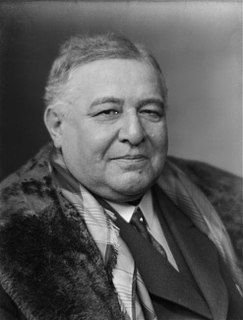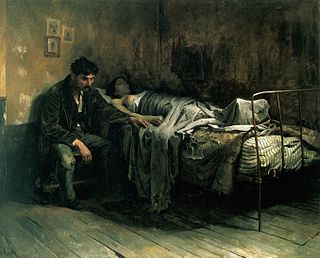
Alphonse Daudet was a French novelist. He was the husband of Julia Daudet (Mastani) and father of Edmée Daudet, and writers Léon Daudet and Lucien Daudet.

Porphyria is a group of liver disorders in which substances called porphyrins build up in the body, negatively affecting the skin or nervous system. The types that affect the nervous system are also known as acute porphyria, as symptoms are rapid in onset and short in duration. Symptoms of an attack include abdominal pain, chest pain, vomiting, confusion, constipation, fever, high blood pressure, and high heart rate. The attacks usually last for days to weeks. Complications may include paralysis, low blood sodium levels, and seizures. Attacks may be triggered by alcohol, smoking, hormonal changes, fasting, stress, or certain medications. If the skin is affected, blisters or itching may occur with sunlight exposure.

Suffering, or pain in a broad sense, may be an experience of unpleasantness and aversion associated with the perception of harm or threat of harm in an individual. Suffering is the basic element that makes up the negative valence of affective phenomena. The opposite of suffering is pleasure or happiness.

Julian Patrick Barnes is an English writer. Barnes won the Man Booker Prize for his book The Sense of an Ending (2011), and three of his earlier books had been shortlisted for the Booker Prize: Flaubert's Parrot (1984), England, England (1998), and Arthur & George (2005). He has also written crime fiction under the pseudonym Dan Kavanagh. In addition to novels, Barnes has published collections of essays and short stories.

Trigeminal neuralgia is a long-term pain disorder that affects the trigeminal nerve. It is a form of neuropathic pain. There are two main types: typical and atypical trigeminal neuralgia. The typical form results in episodes of severe, sudden, shock-like pain in one side of the face that lasts for seconds to a few minutes. Groups of these episodes can occur over a few hours. The atypical form results in a constant burning pain that is less severe. Episodes may be triggered by any touch to the face. Both forms may occur in the same person. It is regarded to be one of the most painful disorders known to medicine, and often results in depression..

Tabes dorsalis is a late consequence of neurosyphilis, characterized by the slow degeneration of the neural tracts primarily in the dorsal root ganglia of the spinal cord. These patients have lancinating nerve root pain which is aggravated by coughing, and features of sensory ataxia with ocular involvement.

Erythromelalgia, formerly known as Mitchell's disease, is a rare vascular peripheral pain disorder in which blood vessels, usually in the lower extremities or hands, are episodically blocked, then become hyperemic and inflamed. There is severe burning pain and skin redness. The attacks are periodic and are commonly triggered by heat, pressure, mild activity, exertion, insomnia or stress. Erythromelalgia may occur either as a primary or secondary disorder. Secondary erythromelalgia can result from small fiber peripheral neuropathy of any cause, polycythemia vera, essential thrombocytosis, hypercholesterolemia, mushroom or mercury poisoning, and some autoimmune disorders. Primary erythromelalgia is caused by mutation of the voltage-gated sodium channel α-subunit gene SCN9A.

Léon Daudet was a French journalist, writer, an active monarchist, and a member of the Académie Goncourt.
The Société littéraire des Goncourt, usually called the académie Goncourt, is a French literary organization based in Paris. It was founded by the French writer and publisher Edmond de Goncourt (1822–1896). He wanted to create a new way to encourage literature in France, and disagreed with the contemporary policies of the Académie française.
Cyclic vomiting syndrome (CVS) is a chronic functional condition of unknown pathogenesis. CVS is characterized as recurring episodes lasting a single day to multiple weeks. Each episode is divided into four phases: inter-episodic, prodrome, vomiting, and recovery. Inter-episodic phase, is characterized as no discernible symptoms, normal everyday activities can occur, and this phase typically lasts one week to one month. The prodrome phase is known as the pre-emetic phase, characterized by the initial feeling an approaching episode, still able to keep down oral medication. Emetic or vomiting phase is characterized as intense persistent nausea, and repeated vomiting typically lasting hours to days. Recovery phase is typically the phase where vomiting ceases, nausea diminishes or is absent, and appetite returns. This syndrome is most commonly seen in children usually between ages 3 and 7, however adult diagnosis is quite common. This disorder is thought to be closely related to migraines and family history of migraines.

Hulusi Behçet was a Turkish dermatologist and scientist. He described a disease of inflamed blood vessels in 1937, which is named after him as Behçet's disease. His portrait was depicted on a former Turkish postcard stamp.

Variant angina, and less commonly Prinzmetal angina,vasospastic angina, angina inversa, coronary vessel spasm, or coronary artery vasospasm, is a syndrome typically consisting of angina in contrast to stable angina which is generally triggered by exertion or intense exercise, commonly occurs in individuals at rest or even asleep and is caused by vasospasm, a narrowing of the coronary arteries due to contraction of the heart's smooth muscle tissue in the vessel walls. In comparison, stable angina is due to the permanent occlusion of these vessels by atherosclerosis.

Broken heart is a metaphor for the intense emotional stress or pain one feels at experiencing great and deep longing. The concept is cross-cultural, often cited with reference to a desired or lost lover.

Throughout history, the disease tuberculosis has been variously known as consumption, phthisis and the White Plague. It is generally accepted that the causative agent, Mycobacterium tuberculosis originated from other, more primitive organisms of the same genus Mycobacterium. In 2014, results of a new DNA study of a tuberculosis genome reconstructed from remains in southern Peru suggest that human tuberculosis is less than 6,000 years old. Even if researchers theorise that humans first acquired it in Africa about 5,000 years ago, there is evidence that the first tuberculosis infection happened about 9,000 years ago. It spread to other humans along trade routes. It also spread to domesticated animals in Africa, such as goats and cows. Seals and sea lions that bred on African beaches are believed to have acquired the disease and carried it across the Atlantic to South America. Hunters would have been the first humans to contract the disease there.
The Aerotoxic Association was founded on 18 June 2007, at the British Houses of Parliament by former BAe 146 Training Captain John Hoyte, to raise public awareness about the ill health allegedly caused after exposure to airliner cabin air that he claimed been contaminated to toxic levels, by engine oil leaking into the bleed air system, which pressurizes all jet aircraft, with the exception of the Boeing 787.
Autophobia, also called monophobia, isolophobia, or eremophobia, is the specific phobia of isolation; a morbid fear of being egotistical, or a dread of being alone or isolated. Sufferers need not be physically alone, but just to believe that they are being ignored or unloved. Contrary to what would be implied by a literal reading of the term, autophobia does not describe a "fear of oneself". The disorder typically develops from and is associated with other anxiety disorders.
Visceral pain is pain that results from the activation of nociceptors of the thoracic, pelvic, or abdominal viscera (organs). Visceral structures are highly sensitive to distension (stretch), ischemia and inflammation, but relatively insensitive to other stimuli that normally evoke pain such as cutting or burning. Visceral pain is diffuse, difficult to localize and often referred to a distant, usually superficial, structure. It may be accompanied by symptoms such as nausea, vomiting, changes in vital signs as well as emotional manifestations. The pain may be described as sickening, deep, squeezing, and dull. Distinct structural lesions or biochemical abnormalities explain this type of pain in only a proportion of patients. These diseases are grouped under gastrointestinal neuromuscular diseases (GINMD). Others can experience occasional visceral pains, often very intense in nature, without any evidence of structural, biochemical or histolopathologic reason for such symptoms. These diseases are grouped under functional gastrointestinal disorders (FGID) and the pathophysiology and treatment can vary greatly from GINMD. The two major single entities among functional disorders of the gut are functional dyspepsia and irritable bowel syndrome.

The Goncourt Journal was a diary written in collaboration by the brothers Edmond and Jules de Goncourt from 1850 up to Jules' death in 1870, and then by Edmond alone up to a few weeks before his own death in 1896. It forms an unrivalled and entirely candid chronicle of the literary and artistic Parisian world in which they lived, "a world", it has been said, "of bitter rivalries and bitterer friendships, in which every gathering around a café table on the Grands Boulevards [was] a chance to raise one's status in the byzantine literary hierarchy". Fear of lawsuits by the Goncourts' friends and their heirs prevented publication of anything but carefully chosen selections from the Journal for many years, but a complete edition of the original French text appeared in the 1950s in 22 volumes, and there have been several selective translations into English.

Ernest-Charles Lasègue was a French physician that released over one hundred scientific papers. He became recognized in the mid-19th century from his work in the fields of psychiatry and neurology. He published many of his works in a journal called Archives Générales de Médecine, in which he was an editor. A few of his major contributions consisted of his work with delusions of persecutions, a concept coined "folie à deux," and his description of hysterical anorexia. Aside from his publications, he worked various jobs before becoming the Chair of Clinical Medicine at Pitié-Salpêtrière Hospital. He remained positioned there until dying at the age of 66 due to complications from diabetes.

In 1557 a pandemic strain of influenza emerged in Asia, then spread to Africa, Europe, and eventually the Americas. This flu was highly infectious and presented with intense, occasionally lethal symptoms. Medical historians like Thomas Short, Lazare Rivière and Charles Creighton gathered descriptions of catarrhal fevers recognized as influenza by modern physicians attacking populations with the greatest intensity between 1557 and 1559. The 1557 flu saw governments, for possibly the first time, inviting physicians to instill bureaucratic organization into epidemic responses. It is also the first pandemic where influenza is pathologically linked to miscarriages, given its first English names, and is reliably recorded as having spread globally. Influenza caused higher burial rates, near-universal infection, and economic turmoil as it returned in repeated waves.
















